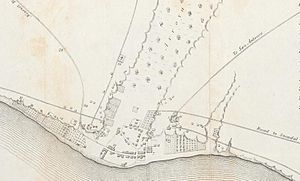| Battle of La Paz | |||||||
|---|---|---|---|---|---|---|---|
| Part of the Pacific Coast Campaign | |||||||
 La Paz disposition of forces in 1847 | |||||||
| |||||||
| Belligerents | |||||||
|
|
| ||||||
| Commanders and leaders | |||||||
|
|
| ||||||
| Strength | |||||||
| 115 infantry [1]: 27 | 200 militia [1]: 38 | ||||||
| Casualties and losses | |||||||
| 1 killed [2]: 164 | 6 killed [2]: 163 | ||||||
The Battle of La Paz was an engagement of the Pacific Coast Campaign during the Mexican–American War. The belligerents were United States Army troops against Mexican militia, commanded by Mexican Army officers. The battle occurred on November 16 and 17, 1847.
Background
In late September, Captain Manuel Pineda Muñoz of the Mexican Army began to assemble a large militia force of farmers and ranchers to defend the Gulf of California region of Mexico from the invading United States military. Hundreds of men were among Pineda's ranks. In March and April 1847, the 1st Regiment of New York Volunteers, an American volunteer regiment from New York State, arrived in San Francisco, California.
Their mission was to reinforce the United States Navy and marines, occupying various Mexican ports to the south and also to take ports themselves. Lieutenant Colonel Henry S. Burton, of the United States Army, was in command. On May 30, 1847, Burton received orders to embark the sloop-of-war USS Lexington with companies A and B and proceed to La Paz for its capture. [1]: 27
On 21 July, 115 men from the Seventh Regiment of New York Volunteers landed peacefully at La Paz. [1]: 27 Lieutenant E. Gould Buffum, of Company B, later described the port city: "The houses were all of adobe, plastered white, and thatched with the leaves of the palm tree, and were most delightfully cool. The whole beach was lined with palms, date, fig, tamarind and coconut trees, their delicious fruit hanging down on them in clusters." [1]: 28
Following the Battle of Mulege, Pineda, as Commandante en Jefe de la Guerilla Guadalupana, set up a provisional capital at San Antonio, raised taxes for defense, started resistance in Oct. at San Jose del Cabo, Comondu and Mulege, and plundered any American sympathizers. [1]: 32 By Nov., Pineda had 300-500 insurgents gathered at San Antonio. [1]: 35
Before departing to capture Mazatlan on 11 Nov., William Shubrick landed 4 sailors and 20 marines at San Jose del Cabo. [1]: 36
Burton's La Paz garrison occupied two houses on the plain commanding the town, on the south side of The Arroyo, with a breastwork of palm logs in front of the officer's house for the 6-pounders. [2]: 162 Additionally, Burton's men used palm logs to barricade the space between the officer's quarters, the church and a house on the west side of town. [2]: 162
Battle
At 2 AM [2]: 153 on 16 Nov., Pineda's brigade of 200 men attacked the American garrison of La Paz, [1]: 38 from the north side of The Arroyo with infantry, while the cavalry waited in the east and south waiting to charge. [2]: 162 Pineda's men fired upon the Americans for about an hour before stopping, waiting until 9 AM to advance, but their advance slackened by 2 PM. [2]: 163 Pineda with 50 men was able to burn former governor Francisco Palacios de Miranda's house, and briefly occupy a house on the lower part of town, before spherical case shot and canister shot forced their retreat, killing 6. [2]: 163
On the morning of 17 Nov., Burton's spherical case shot drove some Mexicans from another house, after which he destroyed the houses on the north side of The Arroyo, strengthened his breastworks, and the roofs of the houses he occupied. [2]: 164
Aftermath
Pineda's men withdrew but continued to hover about the garrison, [2]: 164 eventually resulting in the Siege of La Paz.
References
Further reading
- Nathan Covington Brooks, A Complete History of the Mexican War (The Rio Grande Press, Inc., 1965).
- Justin H. Smith, The War With Mexico, Vols. I and II. (Peter Smith, Gloucester, Mass., 1963).
- John R. Spears, The History of the Navy, Vol. III (Charles Scribner's Sons, New York, 1897), pp. 401–409.
- K. Jack Bauer, Surfboats and Horse Marines (U.S. Naval Institute, Annapolis, Md., 1969).
- President James K. Polk's Message on War with Mexico, May 11, 1846, in Documents of American History, 9th edition, Vol. I (Prentice Hall, Inc., 1979), p. 311.